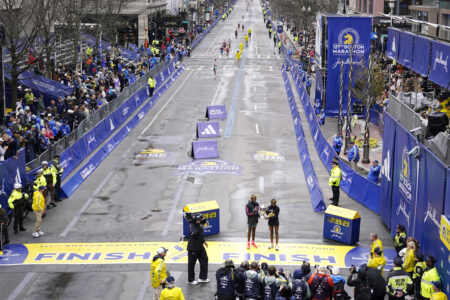It took 75 years for the Boston Marathon to accept women into the race after its first run in 1897. It took only 50 more to forget about them.
Last year, the Boston Marathon celebrated its 50th anniversary of an official women’s race. The coveted Marathon jacket featured a purple stripe commemorating the 1972 move to introduce a second division, one that includes pregnant or postpartum runners, an addition to the already impressive feat of finishing a physically taxing race.
Then this year—year 51—the Boston Athletic Association (BAA) caved to fringe cultural pressure and discovered a new category to be impressed with, or at least pretend to be impressed with.
The BAA added a “non-binary” division for transgender runners.
Since the BAA apparently had to do something – although it didn’t – at least they did not concede to the school of radical gender ideology claiming men can compete as women, which would have fully disintegrated the marathon’s female division that took three quarters of a century to put nto place.
Instead, the BAA provided a new division for any runner confused about his gender, taking foreign hormones, or trying stubbornly to make a statement apart from normal Marathon goals. This year, 27 runners chose to be part of the inaugural non-binary group.
No new androgynous qualifying time will magically appear and prop up the woke cause because, newsflash, “non-binary” isn’t physically possible. So the BAA had to match the qualifying times for this new co-ed category with those of the women’s division. Exercise science is cool that way. Nice and straightforward.
Last year, if you finished 1,000th in the men’s division, the worst you could finish this year in the non-binary division would be 27th! And if last year you missed the men’s qualifying time by 30 whole minutes, never fear! Announce yourself as gender fluid, and you’re back in.
Vermont runner Kae Ravichandran finished first of the 27 “non-binary” runners yesterday with a time of 2:38:56. The Daily Mail reported on Ravichandran’s finish: “She previously competed competitively at Case Western University and ran in men’s division in 2022.”
I’m not a biologist, but…
Ravichandran lamented over having to register as male last year, claiming he debated running Boston at all this year because of the constriction. Sure, you could call it that: constriction, inequality, exclusivity.
It’s a respectable time, no doubt. But at the end of the day, a marathon is a race. Races are inherently exclusive. If you’re not the best, you don’t win. However, as the generation of participation trophies grows up, they believe they are entitled to an award, even if they must invent a new category in which they may be the best.
When you compare Ravichandran’s time to the actual winners, he lost to the men’s first finisher by 33 minutes and to the women’s by 15 minutes. In fact, he lost to several talented and hard-working women—let alone men—whose stories won’t get featured in state-run media.
Kudos to the BAA for not offering prize money to these men in the non-binary category. Can you imagine if they were offering thousands of dollars to the guy who finished behind 529 men and 38 women?
Still, Ravichandran, along with second non-binary finisher Cal Calamia (also male) are getting the attention they crave because they muscled an institution into cowering to their selfish wishes.
The Boston Marathon is a world stage. At one time, it celebrated delayed gratification, months of preparation and self-discipline as well as the power of the human body to accomplish such a feat. It brought women aboard, showcasing that the sex designed to produce the next generation can endure and triumph after the toll of training for one of the toughest courses on earth.
Now, the Boston Marathon joins other hollowed-out, watered-down institutions in a celebration of emasculation, the gradual erasure of women, and a smug satisfaction with mediocrity.


